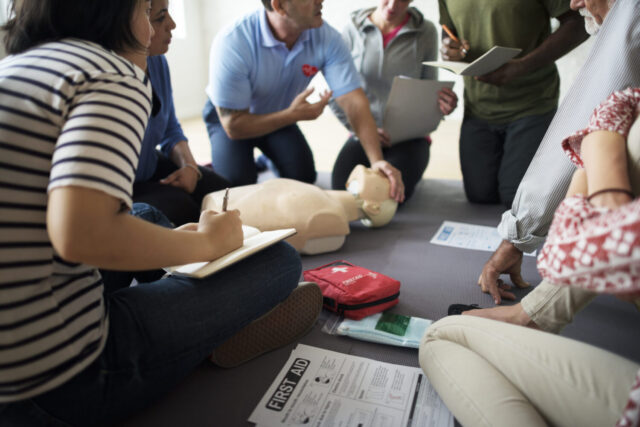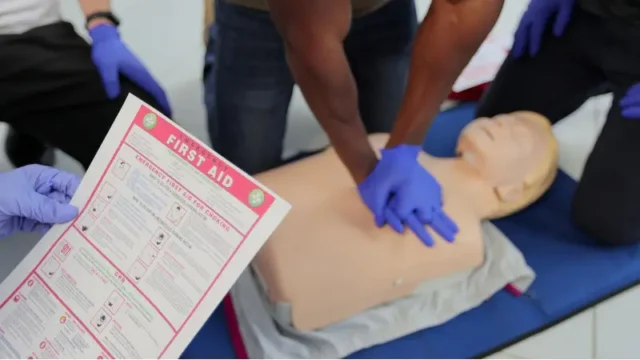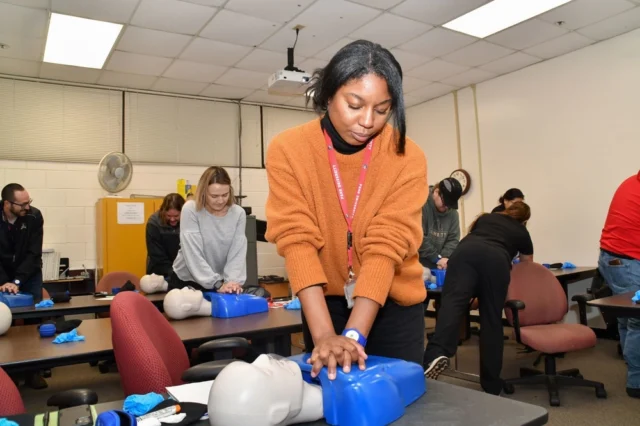
When it comes to the well-being of employees, few measures are as significant and far-reaching as imparting the necessary skills for handling emergency health situations.
Learning to respond effectively to sudden illnesses or injuries is not merely a vital component of a worker’s toolkit but an essential part of fostering a thriving, resilient, and compassionate organizational culture.
From ensuring safety to boosting team morale, training in Cardiopulmonary Resuscitation (CPR) and First Aid creates multifaceted advantages. Here’s an exploration of this essential theme, each component of which resonates with an aspect of human and corporate wellness.
Importance of First Aid and CPR Certification

Having a workforce trained in First Aid and CPR can make the difference between life and death in certain situations. Immediate care for injuries or sudden health crises ensures that conditions don’t worsen and may even resolve until professional medical help arrives. This invaluable skillset allows employees to care for one another, building trust and community within the organization. But it’s not merely about crisis management.
By embedding these life-saving skills within a company’s training framework, we promote a culture that prioritizes well-being, empathy, and preparedness. Workers not only learn how to handle emergencies but are also equipped with a broader understanding of health, cultivating a compassionate environment that values each member’s life and health. If you are interested in providing a certified program to your employees and getting a nice discount, visit https://cprcertificationnow.com/pages/group-discounts.
Enhanced Safety in the Workplace

In the realm of occupational safety, First Aid and CPR training stand as guardians of well-being. Accidents or health issues might occur at any time; having individuals equipped to deal with them ensures a rapid and effective response. The knowledge of what to do in a crisis fosters an overall safer workplace environment, decreasing the risk of severe injuries or fatalities.
Cultivating this atmosphere of safety isn’t simply about reaction but prevention as well. Educated employees are more likely to identify potential hazards and thus help prevent incidents before they happen. By learning the principles of First Aid and CPR, the workforce becomes an active participant in maintaining a safe working environment, reinforcing the organizational commitment to well-being.
Immediate Response to Emergencies
The moments following an accident or sudden illness are crucial. CPR and First Aid-certified employees can provide immediate, potentially life-saving assistance. Timely intervention often makes a critical difference in outcomes, bridging the gap between the incident and the arrival of emergency medical services.
The immediacy of this response doesn’t only concern life-threatening situations. Even in the case of minor injuries, a skilled intervention can prevent complications, ease pain, and provide comfort. A quick response promotes healing and helps maintain the continuity of business operations, minimizing the impact of health-related disruptions.
Confidence and Preparedness

Equipping employees with CPR and First Aid certification not only prepares them to act during emergencies but builds confidence and self-assuredness. When faced with a crisis, this empowerment results in quicker, more controlled responses, unburdened by hesitation or uncertainty.
It’s a benefit that permeates beyond the workplace. These skills carry into personal lives, transforming employees into confident caretakers, ready to assist family, friends, or even strangers in need. This empowerment promotes a holistic approach to well-being, benefiting not just the individual, but the community at large.
Legal Compliance and Liability Reduction
Several jurisdictions require companies to ensure that a portion of their employees are First Aid and CPR certified. Complying with these regulations safeguards businesses against potential legal troubles, but the benefits extend further. A well-trained workforce minimizes the risk of mishandling emergencies, reducing the potential liabilities related to workplace accidents or illnesses.
Though compliance with laws and regulations is mandatory, embracing First Aid and CPR training as a part of the company culture brings about a proactive rather than reactive approach. It demonstrates a commitment to safety and health that goes beyond merely following the rules, reinforcing the company’s reputation and goodwill among employees and customers alike.
Health and Wellness Advocacy

Creating a culture that emphasizes First Aid and CPR conveys a profound commitment to health and wellness. Such training encourages employees to take control of their well-being, both physically and mentally, by recognizing the signs of health issues and knowing how to respond.
Health advocacy is not merely about emergencies. By promoting understanding and awareness of overall health matters, companies foster an environment where prevention is paramount. This has a lasting impact on the everyday lives of employees, fostering a sense of self-care and wellness that permeates both personal and professional spheres.
Team Building and Morale
The bonds forged during First Aid and CPR training sessions can foster a sense of teamwork and camaraderie, unlike any other team-building activity. As employees learn to rely on each other during simulated emergencies, trust, and cooperation are naturally reinforced.
Beyond the training itself, the shared responsibility for safety and well-being enhances the sense of community within the organization. Employees know that their colleagues have their back, creating a nurturing, supportive environment. This mutual reliance strengthens the team’s cohesion, positively influencing morale and productivity.
Cost-Effectiveness and Return on Investment

While there’s an undeniable cost to implementing First Aid and CPR training, the investment yields substantial returns. From preventing serious accidents to minimizing downtime following minor incidents, the financial advantages are significant.
Yet, the returns are not purely monetary. The sense of empowerment, the fostering of a caring community, and the enhancement of safety and well-being – these intangible benefits resonate deeply within the corporate culture. Investing in First Aid and CPR training translates into a human-centric approach that aligns with ethical business practices and enhances the overall standing of the company.
Final Thoughts
Empowering your workforce through First Aid and CPR certification is not merely a strategic decision; it’s a human one. From potentially life-saving interventions to the cultivation of a caring community, the benefits stretch across every facet of personal and professional life.
A wise investment, it reflects a commitment to safety, health, legal compliance, and human connection. As businesses continue to evolve, embracing a culture that values these competencies will not only fulfill legal requirements but foster an environment that resonates with compassion, collaboration, and wellness. The ripple effects of this empowerment will undoubtedly contribute to a more harmonious workplace and a more caring world.









